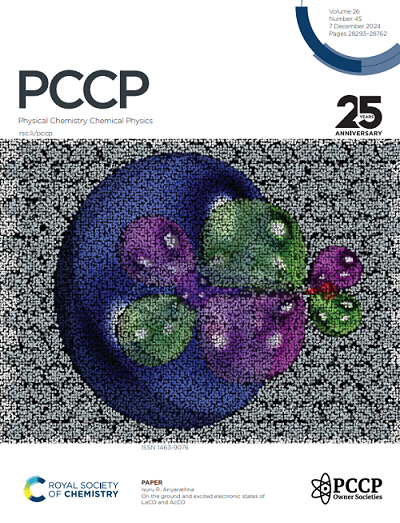The Critical Role of Fe 3d-N 2p Orbital Hybridization in Ammonia Decomposition on graphene-supported Fe6Nx Clusters: A DFT study
IF 2.9
3区 化学
Q3 CHEMISTRY, PHYSICAL
引用次数: 0
Abstract
Ammonia (NH3) is a promising carbon-free hydrogen carrier, but lowering the temperature required for its catalytic decomposition to produce H2 remains a challenge. A main obstacle is the strong adsorption of nitrogen (N) on the active sites, which can remain on the catalyst's surface and lead to poisoning. Using first-principles calculations, we investigate the effects of N accumulation on the Fe6 cluster during NH3 decomposition and aim to develop strategies to mitigate N poisoning. Graphene-supported Fe6 cluster mitigate N poisoning by reducing Fe-N interaction strength, thereby improving NH3 decomposition efficiency. The energy barriers of the graphene-supported Fe6Nx (x=1, 2) clusters’ rate-limiting step has been reduced below 2 eV, compared to those calculated for the pure Fe6 cluster (2.08 eV) and the graphene-supported Fe6 cluster (2.53 eV). The rate-limiting step involves the Fe 3d-N 2p hybridization, during which an adsorbed N atom migrates across the Fe-Fe bond and combines with another N atom to form N2. This study provides new insights into the potential application of graphene-supported metal catalysts for NH3 decomposition.Fe 3d-N 2p 轨道杂化在石墨烯支持的 Fe6Nx 簇上分解氨气过程中的关键作用:DFT 研究
本文章由计算机程序翻译,如有差异,请以英文原文为准。
求助全文
约1分钟内获得全文
求助全文
来源期刊

Physical Chemistry Chemical Physics
化学-物理:原子、分子和化学物理
CiteScore
5.50
自引率
9.10%
发文量
2675
审稿时长
2.0 months
期刊介绍:
Physical Chemistry Chemical Physics (PCCP) is an international journal co-owned by 19 physical chemistry and physics societies from around the world. This journal publishes original, cutting-edge research in physical chemistry, chemical physics and biophysical chemistry. To be suitable for publication in PCCP, articles must include significant innovation and/or insight into physical chemistry; this is the most important criterion that reviewers and Editors will judge against when evaluating submissions.
The journal has a broad scope and welcomes contributions spanning experiment, theory, computation and data science. Topical coverage includes spectroscopy, dynamics, kinetics, statistical mechanics, thermodynamics, electrochemistry, catalysis, surface science, quantum mechanics, quantum computing and machine learning. Interdisciplinary research areas such as polymers and soft matter, materials, nanoscience, energy, surfaces/interfaces, and biophysical chemistry are welcomed if they demonstrate significant innovation and/or insight into physical chemistry. Joined experimental/theoretical studies are particularly appreciated when complementary and based on up-to-date approaches.
 求助内容:
求助内容: 应助结果提醒方式:
应助结果提醒方式:


